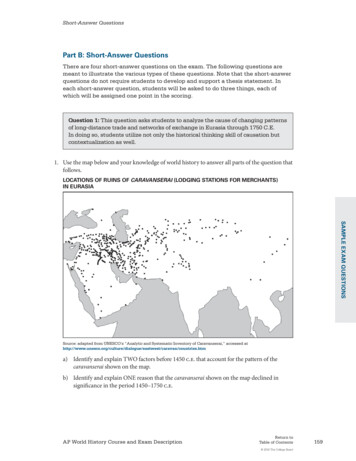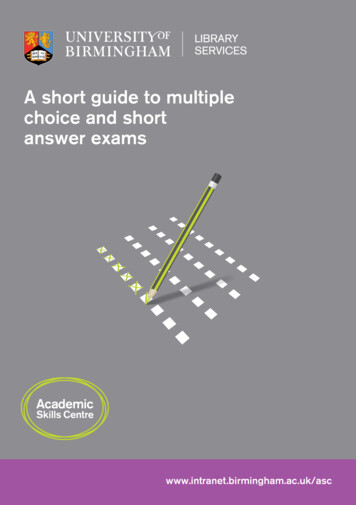
Transcription
This file contains two short excerpts from theLSAT Logic Games Bible, and is designed to brieflyillustrate PowerScore’s methods and writing style.Copyright 2002-2013 by PowerScore Incorporated.All Rights Reserved. No part of this publication may be reproduced, stored in a retrieval system, ortransmitted in any form or by any means electronic, mechanical, photocopying, recording, scanning, orotherwise, without the prior written permission of the Publisher. Parts of this book have been previouslypublished in other PowerScore publications and on the powerscore.com website.All actual LSAT questions printed within this work are used with the permission of Law SchoolAdmission Council, Inc., Box 2000, Newtown, PA 18940, the copyright owner. LSAC does not reviewor endorse specific test preparation materials or services, and inclusion of licensed LSAT questionswithin this work does not imply the review or endorsement of LSAC. LSAT is a registered trademarkof LSAC.LSAT, and PrepTest are registered trademarks of the Law School Admission Council, Inc.PowerScore is a registered trademark. The LSAT Bible Series , The Logic Games Bible , TheGames Bible , The Logical Reasoning Bible , The Reading Comprehension Bible , The LSATsDeconstructed , The LSAT Training Type Series , The Not Law and its visual representation, NotBlocks , The Separation Principle , The Unified Grouping Theory , Defined/Undefined/PartiallyDefined , Uniform/Subdivided , Balanced/Unbalanced , Overloaded/Underfunded , Moving/Fixed ,Hurdle the Uncertainty , the Double Not-Arrow and its visual representation, the Hierarchy of GamePower , Identify the Possibilities , and Identify the Templates are the exclusive service marked propertyof PowerScore. The entire Logic Games’ classification and game representation systems used within thisbook were created by PowerScore and are the exclusive service marked property of PowerScore. Anyuse of these terms or of these systems without the express written consent of PowerScore is MPublished byPowerScore Publishing, a division of PowerScore Incorporated57 Hasell StreetCharleston, SC 29401Author: David M. KilloranEditorial Assistance: Terry Bray and Steven G. SteinManufactured in CanadaMay 2013ISBN: 978-0-9887586-6-7TM
ContentsChapter One: IntroductionIntroduction. 3A Brief Overview of the LSAT. 5The LSAT Scoring Scale. 7The LSAT Percentile Table. 7The Use of the LSAT. 8Chapter Two: Analytical Reasoning BasicsThe Analytical Reasoning Section. 11The Step Between the Rules and the Questions. 13Approaching the Games in General . 14Setups and Diagramming. 15The Questions—Part 1 . 19Attacking the Section. 21Chapter Two Quick Review. 23Chapter Three: Linear GamesThe Concept of Linearity. 27Rule Representation. 35Internal versus External Diagramming. 72Making Inferences. 74Balanced versus Unbalanced Games. 83The Step Between Diagramming and the Questions. 85The Questions—Part 2. 110Six Specific Question Types. 125Attacking the Questions. 134Placing Diagrams. 143Final Pregame Note. 147Official LSAT Logic Games—Linear Games. 149The PowerScore LSAT Logic Games BibleI
Chapter Four: Advanced Linear GamesMultiple Stacks. 183Diagramming with Multiple Stacks. 186Two Linear Inference Principles. 198Final Pregame Note. 202Official LSAT Logic Games—Advanced Linear Games. 203Chapter Five: Grouping GamesThe Principle of Grouping. 231Unified Grouping TheoryTM. 234Diagramming the Rules. 242Advanced Conditional Reasoning. 243Making Inferences. 258Avoiding False Inferences. 266Note. 272Final Pregame Note. 296Official LSAT Logic Games—Grouping Games. 297Chapter Six: Grouping/LinearCombination GamesWorking with the Combination of Major Principles. 331Final Pregame Note. 354Official LSAT Logic Games—Grouping/Linear Combination Games. 355Chapter Seven: Pure Sequencing GamesPure Sequencing Games. 369Conditional Sequencing. 379Final Pregame Note. 388Official LSAT Logic Games—Pure Sequencing Games. 389IIThe PowerScore LSAT Logic Games Bible
Chapter Eight: The Forgotten FewThree Rare Game Types. 403Pattern Games. 404Final Pregame Note. 410Official LSAT Logic Games—Pattern Games. 411Circular Linearity Games. 425Official LSAT Logic Games—Circular Linearity Games. 427Mapping Games. 432Official LSAT Logic Games—Mapping Games. 435Chapter Nine: Advanced Features andTechniquesTwo Difficult Question Types. 443Numerical Distributions. 461Final Pre-Drill and Game Note. 469Official LSAT Logic Games—Numerical Distribution Games. 473Limited Solution Set Games. 484Identify the TemplatesTM. 484Identify the PossibilitiesTM. 485How to Identify Limited Solution Set Games. 486Final Pregame Note. 488Official LSAT Logic Games—Identify the TemplatesTMand Identify the PossibilitiesTM Games. 489The PowerScore LSAT Logic Games BibleIII
Chapter Ten: Section Strategyand ManagementApproaching the Section Strategically. 511Using a Timer. 514Pacing Guidelines . 516Question Attack Strategies. 518Limited Time Strategies. 521The Answer Choices. 523Guessing Strategy. 524Test Readiness. 527Final Note. 530Logic Games ReChallengeLogic Games ReChallenge Set #1. 535Logic Games ReChallenge Set #2. 545Logic Games ReChallenge Set #3. 555Logic Games ReChallenge Set #4. 565Logic Games ReChallenge Set #5. 575Logic Games ReChallenge Set #6. 585Logic Games ReChallenge Set #7. 595IVThe PowerScore LSAT Logic Games Bible
AppendicesAppendix One: Comprehensive Game Classification. 605Appendix Two: Consolidated Answer Key. 607Appendix Three: Flawed Setups: Checks, X’s, and O’s. 613Glossary and IndexAlphabetical Glossary and Index. 615The PowerScore LSAT Logic Games BibleV
Making InferencesInferences are relationships that must be true in a game but are notexplicitly stated by the rules or game scenario. One of the keys to powerfulgames performance is making inferences after you have diagrammed all ofthe rules. In some games, a single inference can be the difference betweenthe game seeming easy or difficult. For some people inference making isintuitive, and for others it is very difficult. Here are three basic but timetested strategies for making inferences:31. LinkageLinkage shouldalways be thefirst step youtake to makeinferences.Linkage is the simplest and most basic way to make inferences. Linkageinvolves finding a variable that appears in at least two rules and thencombining those two rules. Often that combination will produce aninference of value. Consider the following two rules:K must be played before L.L must be played before M.Individually the two rules would be diagrammed as follows:K LL MIf we represented Not Laws from each rule, we would have the following:123456L KM LThree variablesin a sequencesimilar to theone to the rightalways yield 6Not Laws.Clearly, “L” is common to both rules. By combining the rules we come upwith the following relationship:K L MWe can now infer that K must be played before M, and this informationhelps us to establish all of the applicable Not Laws:123456LMKKM LLinkage between the rules should always be the first place you look todiscover inferences. Incidentally, the above example again proves the74The PowerScore LSAT Logic Games Bible
value of reading all of the rules before you begin diagramming. If you haddiagrammed each rule individually, then later discovered the linkage, youwould then have had to return to the two rules and diagram the additionalimplications of the linkage. That would be an inefficient approach and thusdetract from your performance.These examplesof linkage allrelate to Lineargames. Otherlinkage exampleswill appear inthe chaptersdevoted to othergame types.Here is another example featuring linkage:If Q is displayed fourth, then R must be displayed first.R and S are displayed consecutively.Individually the two rules would be diagrammed as follows:Q4R1RSS R123456However, if R is first, then according to the second rule S must be second,which should be written as:Q4R1, S2Thus, combining the two rules leads to the further inference that S must besecond when Q is fourth. Although this cannot be represented directly onthe diagram, this relationship can and should be displayed as above, as anaddition to the original representation of the first rule.Here is a final example featuring linkage:W and X cannot speak consecutively.X must speak third or fifth.Individually the two rules would be diagrammed as follows:WXX W X/ /X123456At first, it may appear that linking the two rules yields no inference, butif X is always third or fifth, then W can never be placed fourth (to do sowould cause a violation regardless of whether X was third or fifth). Thisleads to a W Not Law on 4:X/ /X12345WChapter Three: Linear GamesAlthough thesethree exampleseach featurelinkage betweentwo rules, thereare situationsthat arise wherethree rules arelinked.6753
2. Rule CombinationsAs we study more and more game types, your arsenal of rule recognitionskills will increase. In certain games, there are classic combinations whichalways yield certain inferences. In contrast to linkage, however, makinginferences from rule combinations does not rely upon the connectionof a variable common to two or more rules. For example, consider thisscenario:3Six lawyers—H, J, K, L, M, and O—must speak at a convention. The sixspeeches are delivered one at a time, consecutively, according to the followingrestrictions:K and L must speak consecutively.O must speak fifth.From the scenario and rules above, we can draw the following diagram:HJKLMO6OKL123456LK KLBecause of the interaction of the two rules, we can infer that K and L cannever speak sixth (there is not enough room for K and L to be next to eachother). In addition, because O must speak fifth, only H, J, and M remain aspossible candidates to speak sixth. This could be shown as a triple-option(H/J/M):HJKLMO6O H/J/MKL123456LK KLThis type of rule combination is one of many we will discuss in this book.76The PowerScore LSAT Logic Games Bible
3. RestrictionsIn Logic Games always look to the restricted points for inferences.Restricted points are the areas in the game where only a few optionsexist—for example, a limited number of variables to fill in a slot, ablock with a limited number of placement options, or a slot with a largenumber of Not Laws. If you can identify a restriction, generally there areinferences that will follow from your examination of that point. The trickis to determine exactly where the restrictions in a game actually occur.Note that rulecombinationinferencesare normallyproduced by arestriction thatresults fromcombining thetwo rules.Consider the following example:A salesman must visit five families—the Browns, the Chans, the Duartes, theEgohs, and the Feinsteins—one after another, not necessarily in that order. Thevisits must conform to the following restrictions:The Browns must be visited first or fifth.The Feinsteins cannot be visited third.The Chans must be visited fourth.Using the scenario and rules above, we can produce the followingdiagram:BCDEF5B/ C1234BBBF/B5The easiest way to find restrictions in a game is to examine the Not Lawsfor each slot. The slot with the most Not Laws may be so restricted that ithas a limited number of possibilities. In this case, the third slot is the mostrestricted active slot since it has two Not Laws. Technically, the fourth slotis the most restricted since it has only one option, the Chans. But, sincethe fourth slot has already been filled by the Chans, it is no longer “active”and we can disregard it from further consideration. However, since theChans have been placed, they cannot go in any other slot, and so it is nowtrue that neither B, C, nor F can be visited third. Since there are only fivefamilies to visit and B, C, and F have been eliminated from contention, itfollows that either D or E must be visited third. That inference should beshown with a D/E dual-option on the third slot:BCDEF5B/D/E123BBFC4BChapter Three: Linear Games/B5773
Restrictions also frequently occur with blocks, especially split-blocks.Consider the following scenario:A child must play five games—P, Q, R, S, and T—one after another, notnecessarily in that order. The games must be played according to the followingconditions:The child plays exactly two games between playing S and playing T,whether or not S is played before T.P is played immediately before Q is played.3Once again, using the scenario and rules, we can produce the followinginitial setup:PQRST5S/T T/S12345P Q Q S PTBlocks have areduced numberof spacingoptions andas such theycan play a verypowerful role ingames.As usual, P cannot be played fifth since Q must be played behind it, and Qcannot be played first since P must always be played ahead of it. However,the S and T split-block is more interesting because it has a limited numberof spacing options. In fact, the ST split-block can only be placed intopositions 1-4 or 2-5. Thus, neither S nor T can be played third. At thispoint it appears that we have our inferences and that we are ready tocontinue on. But consider the interaction of the two blocks. If S and T arein the 1-4 position, then P and Q must be in 2-3. If S and T are in the 2-5position, then P and Q must be in the 3-4 position. That means that eitherP or Q must always be played third. Additionally, we can infer that R mustalways be played first or fifth:PQRST5S/T T/SR/P/Q/R12345P Q Q S PTGiven these inferences, there are only two possible “templates” to thegame based on the placement of the two blocks:Template #2:Template #1:RS/T1S/TP2PQ3QT/S4T/SR5These two templates encompass four solution sets to the game and make itabundantly clear how the interaction of some rules and game restrictions78The PowerScore LSAT Logic Games Bible
can set off a series of powerful inferences. In a later chapter we willdiscuss templates in detail, but you will see references to this approachthroughout the book. Templates result from restrictions within the game,and in many games the best setup is one that shows these possibilityblueprints.Consider one more example:3A doctor must see six patients—C, D, E, F, G and H—one after another, notnecessarily in that order. The patients must be seen according to the followingconditions:E is seen exactly three patients after C.D is seen immediately before F is seen.Using the scenario and rules, we can produce the following initial setup:CDEFGH6C E123456D F EEECCCF DAlthough this game has restrictions—the placement of the CE split-blockis limited to 1-4, 2-5, or 3-6—there are still many different solutions.However, suppose for a moment that the test makers asked a question thatcontained a specific condition, such as:If G is seen third, which one of the following must be true?The addition of this new condition affects the restrictions in the basicdiagram to such an extent that only one solution is possible:Step One: G is seen thirdG123456Step Two: The CE split-block must be placed into slots 1-4because if it is placed in slots 2-5 there will be no room for the DFblockC G123E45Chapter Three: Linear Games679
Step Three: The DF block must be placed into 5-6C G123E4D5F6D5F6Step Four: H must be placed into 23C1Randoms areweaker variablesthat typicallyare placed aftermore powerfulvariables havebeen placed.H2G3E4Note that the random H, a variable with little power, is placed last.After completing these steps in response to the question, you could thenuse the single solution to easily select the correct answer choice.The point is that restrictions, when present in a game, never go away. Youmust always track them and be prepared for questions that will force youto address the restriction.Avoiding False InferencesThe test makers always check to see if you have interpreted the rulescorrectly, and some rules are easier to misinterpret than others. Here arefour mistakes that students often make:Conditional Rule ReversalAs previously discussed, a conditional rule is triggered when the sufficientcondition occurs. For example, consider the following rule:When M is shown first, then O is shown sixth.This rule would be diagrammed as:M1O6When M appears in the first slot, then O must appear in the sixth slot.However, many test takers make the mistake of reversing the relationship,and when faced with O in the sixth slot, they assume that M must be inthe first slot. This is not a valid inference, and this mistake is known as aMistaken Reversal.80The PowerScore LSAT Logic Games Bible
Misinterpreting Block LanguageAs discussed on pages 39 through 47, the test makers will use differentlanguage to denote different types of blocks. “Before” and “after” areused in one manner, whereas “between” has an entirely different meaning.Many students make the mistake of misreading this language, and thenthey draw inferences based on a relationship that is actually incorrect. Youmust always read each rule very carefully because making a mistake in therules will almost always cause a high number of missed questions.3False BlocksThe test makers are savvy, and they know that the average student does notcarefully read the language of the rules. Consider the following rule from arecent Linear game:Each rock classic is immediately preceded on the CD by a newcomposition.In this game, songs were being selected for a demo CD, and each songwas classified as either a rock classic (R) or a new composition (N). Moststudents, upon reading the rule above, immediately diagrammed the ruleas follows:NRHowever, this representation is incorrect. The diagram above implies thatR and N are always in a block formation—that is, every time N appearsthen R immediately follows, and every time R appears then N immediatelyprecedes. Take a moment to re-read the rule. Does the rule state that thetwo variables are in block formation? No, what the rules states is thatevery rock classic is preceded by a new composition. There is no statementthat every new composition is followed by a rock classic. So, this rule isonly triggered when a rock classic is present. Thus, the rule is conditional,and should be diagrammed as follows:RNRThis representation correctly indicates that the relationship in the ruleoccurs when a rock classic is present. Under this representation, itbecomes possible for two or more new compositions to appear in a row(NN, NNN, etc.).Chapter Three: Linear Games81
False Not-Block InferencesAs discussed on page 47, not-blocks indicate that variables cannot be nextto one another, or cannot be separated by a fixed amount of space. Somestudents make the mistake of combining not-blocks with Not Laws toarrive at false inferences. Consider the following two rules:3B is not inspected the day before C is inspected.C cannot be inspected second.The diagram for these two rules would be:BC12C3456Many students, after reviewing these two rules, make one of the followingtwo errors:1. They mistakenly conclude that B cannot be inspected first, andthen place a B Not Law under slot 1. These students erroneouslyact as if the BC relationship is a regular (or positive) block:because C cannot be inspected second, if BC was a regular block,then B could not be inspected first.2. They mistakenly conclude that B must be inspected second, andthen place B into slot 2. The error here is to act as if the C Not Lawon slot 2 then forces B into slot 2. That outcome does not have tooccur, although, of course, B could be inspected second.Remember, not-blocks only come into play when one of the variables inthe not-block is placed on the diagram.82The PowerScore LSAT Logic Games Bible
Also from PowerScore’sLSAT Logic Games Bible:
Conditional SequencingIn certain Logic Games, some of the sequencing rules are stated inconditional fashion, meaning that certain sequential relationships aretriggered by other events. These rules tend to come in two types: standardconditional relationships, and relationships that trigger two mutuallyexclusive possibilities. Let’s examine both.ConditionalSequencing rulescan occur in bothPure Sequencingand Basic orAdvanced Lineargames.Standard Conditional RelationshipsSequencing elements can be added to any conditional relationship, inthe sufficient or necessary condition (or both). Consider the followingexample:If D is taller than F, then X is taller than Y.This rule is only enacted if D is taller than F, and most students diagramthe rule as follows:D FX YThe contrapositive of the rule is a bit more interesting. Diagrammingsimply with negatives, the contrapositive appears as:X YD FHowever, if this game includes no ties—and most Logic Games explicitlyeliminate the possibility of ties—then when X is not taller than Y, it mustbe that Y is taller than X, and when D is not taller than F, it must be that Fis taller than D. When this information is taken into account, the rule canbe redisplayed as follows:Y XLinear gamesoften includeConditionalSequencing rules,and typically thesequence is tiedto a specificoccurrence,such as in thefollowing example:“If L is third,then P must bescheduled earlierthan S.” Sucha rule would bediagrammed as:L3P SThus, wheneverL is third, thesequence isforced to occur.F DThus, one of the most important considerations when you encounter aconditional sequencing rule is to examine the contrapositive, and if thereare no ties, redisplay the relationships in a way that removes any negatives.Chapter Seven: Pure Sequencing Games3797
Mutually Exclusive OutcomesIn some cases, conditional sequencing rules can create two separate,mutually exclusive possibilities that then dictate the direction of the game.Consider the following example:Either R is taller than S, or else R is taller than T, but not both.Most students diagram the rule as follows:R SorR TWhile this representation is factually accurate, it does not capture the fulltruth of what is occurring with R, S, and T. Note that the rule uses thephrase “but not both,” which means that one or the other occurs, but thatboth cannot occur. So, when R S, it cannot also be the case thatR T, and vice versa. But, in games in which no ties are possible (andmost games fall into that category), if R is not taller than T, then T must betaller than R (T R). When this relationship is added to the existing R S,relationship, we can infer that T R S.7A similar case exists when R T. Because R S cannot also be true, wecan infer that S R, creating a chain of S R T.Therefore, under this rule, only two arrangements of R, S, and T arepossible:1. T R Sor2. S R TThus, every solution to the game will conform to either the T R Ssequence or to the S R T sequence. This is an incredibly powerfulinference, and one that divides the game into two fundamentally differentpathways. If you encounter a game that contains a similar rule, you shouldimmediately recognize that two distinct possibilities exist, and exploreboth options in terms of how they interact with the remaining rules.Note also that the initial rule, while conditional in nature, does not use380The PowerScore LSAT Logic Games Bible
one of the most common indicators (such as “if” or “only”) to createconditionality. Instead, the conditional phrase “either/or, but not both” isused. Interestingly, in many of the conditional sequencing rules that createjust two possible directions for the game, the phrase “but not both” ispresent.Here is another example that also creates two separate, mutually exclusivepossibilities, along with the two separate directions that result:Example: R sings at some time before S or at some time after L,but not both.S1. R - - - Lor2.S---- RL7Rules that create two distinct pathways have become increasingly commonon recent LSATs, and you must recognize these rules when they appear,and understand the implications created by such rules. Here are severalgames you can review that feature similar rules:December 2006 LSAT, Game #2September 2007 LSAT, Game #4December 2007 LSAT, Game #2October 2010 LSAT, Game #2However, when considering conditional rules involving sequencing,be careful not to assume that any sequencing rule stated in cond
76 The PowerScore LSAT Logic Games Bible 3 2. Rule Combinations As we study more and more game types, your arsenal of rule recognition skills will increase. In certain games, there are classic combinations which always yield certain inferences. In contrast to











